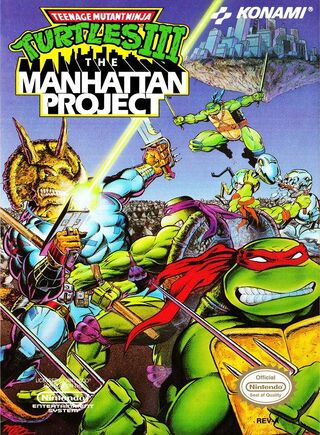Teenage Mutant Ninja Turtles III: The Manhattan Project: Difference between revisions
(link TMNT) |
No edit summary |
||
| Line 5: | Line 5: | ||
publisher = [[Konami]]| | publisher = [[Konami]]| | ||
systems = [[Nintendo Entertainment System|NES]], [[PlayStation 4|PS4]], [[PlayStation 5|PS5]], [[Nintendo Switch|Switch]], [[Xbox One]], [[Xbox Series X/S]], [[Windows]]| | systems = [[Nintendo Entertainment System|NES]], [[PlayStation 4|PS4]], [[PlayStation 5|PS5]], [[Nintendo Switch|Switch]], [[Xbox One]], [[Xbox Series X/S]], [[Windows]]| | ||
release = '''Famicom/NES'''<br /> | release = '''Famicom/NES'''<br />Japan: December 13, 1991<br />Mexico, United States: February 1, 1992<br />'''PS4, PS5, Switch, Xbox One, X/S, Windows'''<br />WW ([[Teenage Mutant Ninja Turtles: The Cowabunga Collection|Cowabunga Collection]]): August 30, 2022| | ||
added_to_museum = PS4 ([[Teenage Mutant Ninja Turtles: The Cowabunga Collection|Cowabunga Collection]]): March 24, 2022| | added_to_museum = PS4 ([[Teenage Mutant Ninja Turtles: The Cowabunga Collection|Cowabunga Collection]]): March 24, 2022| | ||
}} | }} | ||
'''''Teenage Mutant Ninja Turtles III: The Manhattan Project''''' was a beat 'em up [[video game]] by [[Konami]]. | '''''Teenage Mutant Ninja Turtles III: The Manhattan Project''''' was a beat 'em up [[video game]] by [[Konami]] for the [[Nintendo Entertainment System]]. | ||
It was based on the [[Teenage Mutant Ninja Turtles]] from the 1987 animated series. | It was based on the [[Teenage Mutant Ninja Turtles]] from the [[1987]] animated series. | ||
==Versions== | |||
The first ''Teenage Mutant Ninja Turtles'' game for the [[Family Computer]] in Japan was titled ''[[Teenage Mutant Ninja Turtles (video game)|Geki Kame Ninja Den]]'', or ''Legend of the Radical Ninja Turtles'' in English. | |||
The second game in the series released for the Family Computer, or Famicom, was a port of the [[arcade]] game. It was known in Japan as ''[[Teenage Mutant Ninja Turtles (arcade game)|Teenage Mutant Ninja Turtles ~Sūpā Kame Ninja~]]'', or as ''Teenage Mutant Ninja Turtles ~Super Ninja Turtles~'' in English. | |||
Because only the arcade port bore the ''Teenage Mutant Ninja Turtles'' brand in Japan, the Famicom release had the title '''''Teenage Mutant Ninja Turtles II: The Manhattan Project'''''. | |||
The game was released for Famicom in Japan on December 13, [[1991]], followed by a release on the Nintendo Entertainment System in Mexico and the United States on February 1, [[1992]]. | |||
The | |||
[[Category: Beat 'em up video games]] | [[Category: Beat 'em up video games]] | ||
Revision as of 16:44, 12 June 2024

| |
| Teenage Mutant Ninja Turtles III: The Manhattan Project | |
| Developer | Konami |
|---|---|
| Publisher | Konami |
| Platforms | NES, PS4, PS5, Switch, Xbox One, Xbox Series X/S, Windows |
| Released | Famicom/NES Japan: December 13, 1991 Mexico, United States: February 1, 1992 PS4, PS5, Switch, Xbox One, X/S, Windows WW (Cowabunga Collection): August 30, 2022 |
| Added to Museum |
PS4 (Cowabunga Collection): March 24, 2022 |
Teenage Mutant Ninja Turtles III: The Manhattan Project was a beat 'em up video game by Konami for the Nintendo Entertainment System.
It was based on the Teenage Mutant Ninja Turtles from the 1987 animated series.
Versions
The first Teenage Mutant Ninja Turtles game for the Family Computer in Japan was titled Geki Kame Ninja Den, or Legend of the Radical Ninja Turtles in English.
The second game in the series released for the Family Computer, or Famicom, was a port of the arcade game. It was known in Japan as Teenage Mutant Ninja Turtles ~Sūpā Kame Ninja~, or as Teenage Mutant Ninja Turtles ~Super Ninja Turtles~ in English.
Because only the arcade port bore the Teenage Mutant Ninja Turtles brand in Japan, the Famicom release had the title Teenage Mutant Ninja Turtles II: The Manhattan Project.
The game was released for Famicom in Japan on December 13, 1991, followed by a release on the Nintendo Entertainment System in Mexico and the United States on February 1, 1992.
The